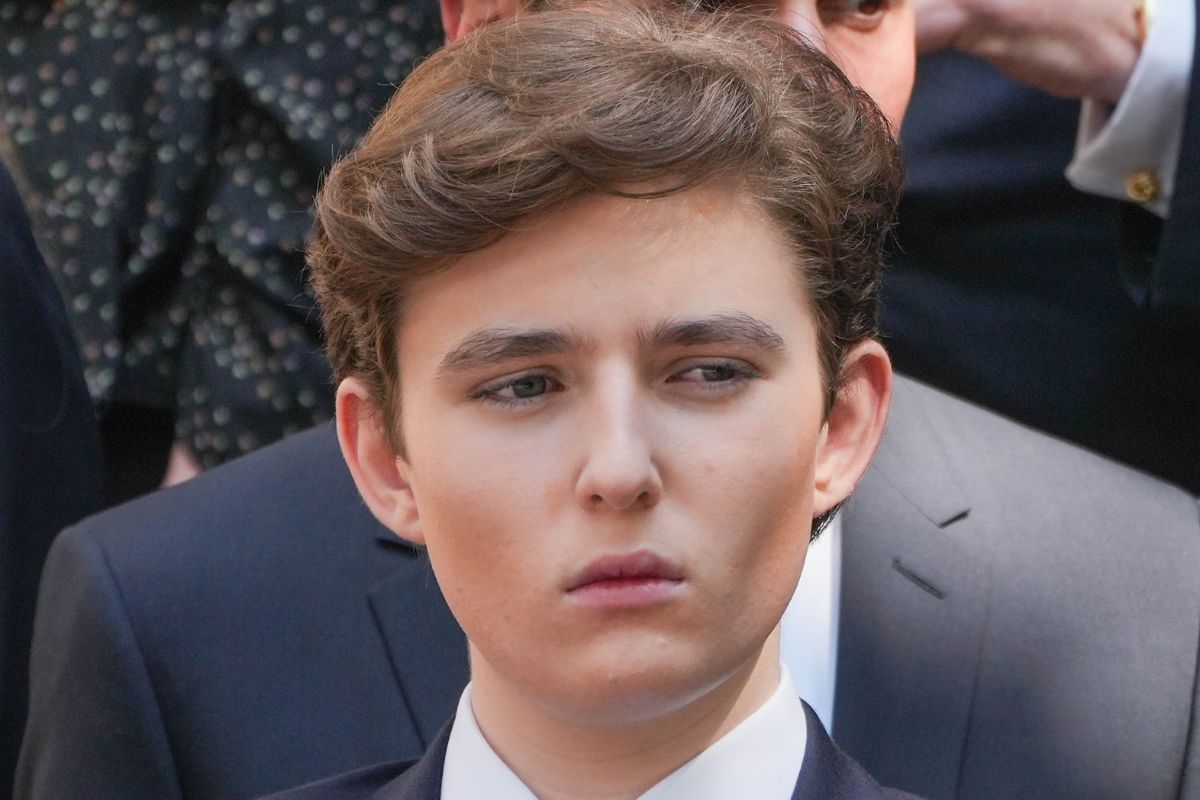Donatella Versace, tiny, sculpted and forever blonde, was standing backstage after her menswear show at the Teatro Versace in Milan in June, receiving polite congratulations from a handful of editors and friends. The scene was positively dead compared with Versace shows a decade ago: no celebrities posing with Donatella for paparazzi, no bodyguards holding back the throngs, and no pals swilling champagne. Donatella's brother Santo, in his usual charcoal suit with black turtleneck, came back for a few minutes to shake some hands. Her husband, American-born Paul Beck, tall and tan, stood alone in the corner; no one even noticed him. It all felt feeble, pathetic—a sad, soulless charade to promote something that no longer exists.
The nonscene is a reflection of how far the Italian fashion house has fallen since its founder's death. When Gianni Versace was murdered on the front steps of his Miami mansion in 1997, the company immediately announced that his strong-minded sister, Donatella, would take over as creative director and his brother, Santo, would be CEO. The decision made sense at the time. The luxury fashion business was soaring, thanks to the new wealth of the Internet boom, and Gianni Versace was a favorite of the bling set, with his flashy designs, celebrity friends, and lavish lifestyle. The company was poised to become a luxury megabrand like Gucci, Giorgio Armani, and Louis Vuitton.
Instead, Donatella plunged into profound drug addiction and made erratic business and creative decisions. While competing fashion brands turned into global powers, Versace has watched its sales plummet from $1 billion in 1996 to less than half that today. Major retailers such as Neiman Marcus and Bergdorf Goodman have dropped the line. The company has lost both its prestige and design influence.
Starting in 2003, after what Santo described as "seven years of woes," the Versace siblings acknowledged they couldn't run the company by themselves and hired a string of outside managers to straighten out the mess. But the outsiders failed too—in large part, Versace sources say, due to Donatella's and Santo's resistance to change. "The industry had changed and they did not evolve," says a former Versace executive who would speak only on condition of anonymity.
In June, Giancarlo di Risio, Versace's CEO for five years, abruptly left. Sources say di Risio proposed more rigorous cost-cutting—with a particular focus on its owners' high-flying lifestyle—in response to the economic crisis and Donatella didn't agree. The House of Versace has denied this publicly and declined to comment for this story. Immediately following di Risio's departure, the company hired management consultants at Bain & Co. to come up with a three-year plan to get back on track; it also hired a new CEO, Gian Giacomo Ferraris, from Jil Sander. To some extent, it's remained business as usual at Versace: last month Donatella jetted off to New York to host the Whitney Museum's annual black-tie gala, which Versace sponsored, and then to Brazil for the Rio Rocks Fashion extravaganza, where she co-hosted a grand charity dinner at the Copacabana Palace and hung out with Diddy and photographer Mario Testino. Days later, however, Ferraris announced the layoff of 350 employees—roughly a quarter of the company—as part of a "comprehensive corporate reorganization" to put Versace back in the black by 2011.
With the fashion industry reeling from the lingering recession, many in the business wonder whether Bain's prescriptions will be enough to save Versace. "The old family way is not the new modern way," says Tom Julian, president of the Tom Julian Group, a brand consultancy in New York City. "Whether it's McKinsey or Bain or Boston Consulting Group, these reputable firms have very strong recommendations, but it may not take hold or help the brand, given the hemorrhaging."
For better or worse, the Versace siblings have always been devotees of the "old family way." In their hometown of Reggio di Calabria in southern Italy, their father, Antonio, was a methane-gas and coal merchant; their mother, Francesca, was a dressmaker who had a shop called Elle. The family lived in an apartment above the store. As a youth, Gianni helped his mother in the shop. "I shuttled back and forth between Reggio and Messina, I took the ferry and each time tried to choose more beautiful and extraordinary materials," he wrote in his book, Designs. Before his mother would cut expensive fabrics, he recalled, she would say a prayer.
Gianni's brother, Santo, who was two years older, studied business administration at the University of Messina and helped out on the commercial side of the mother's business. Their baby sister, Donatella—11 years younger than Gianni—hung out at the shop and was fascinated with fashion. She stomped around Reggio in platform shoes; as a teen, she was already bleaching her long hair platinum blonde.
In 1972, Gianni moved to Milan to work as a freelance fashion designer for a midpriced ready-to-wear brand. Donatella was studying in Florence to become a teacher, traveling to Milan on the weekends to party with Gianni. By the mid-'70s, Gianni had decided to start his own fashion house, like fellow Milan designers Giorgio Armani and Gianfranco Ferré. With the help of Santo, Gianni put together the financing, and, in 1978, he launched Gianni Versace. Santo was the president, Donatella the muse.
Gianni's designs—short, tight, and shiny (inspired, he said, by Italian hookers)—shocked the staid Italian fashion establishment but quickly became a hit with the nightclub scene. And though fashion editors and retailers personally found Versace's silver metal–mesh minidresses and black leather microskirts to be vulgar—they were the absolute antithesis of Armani's quiet chic and Valentino's restrained elegance—they looked fantastic in store windows and magazine pages. In a matter of a few seasons, Versace made tacky not only acceptable but enviable. The first year's sales were approximately $15 million; within 10 years they reached $353 million. In 1996 Versace topped the $1 billion mark, with approximately half of revenues coming via licenses and 80 percent of sales coming from outside of Italy.
With his newly earned wealth, Gianni began to invest in serious real estate and live the decadent lifestyle that helped draw attention to the brand. In 1977 he bought an abandoned property on Lake Como, Italy, called Villa Fontenelle and set upon restoring it to its early 19th-century glory. In 1992 he paid $2.9 million for the Amsterdam Palace, an elegant 1930s apartment complex on Miami's South Beach, and another $3.7 million for the hotel next door, which he demolished to make room for gardens and a swimming pool. He rechristened it Casa Casuarina and flew in artisans to add sumptuous mosaics, frescoes, and fountains. Two years later he acquired a stately townhouse in Manhattan. In Miami, Gianni hosted hedonistic weekends for his celebrity friends Elton John, Sting, and Naomi Campbell; Madonna would stay in a suite that Gianni did up in red and gold just for her. But his family remained the centerpiece of his life, in particular Donatella's daughter, Allegra, whom Gianni referred to as his "little princess." He had great ambitions for her, even telling reporters that someday he wanted her to run the company.
Throughout the late '80s and early '90s, the company opened stores in the world's capitals. Versace presented his haute couture collection at rowdy, celebrity-filled shows at the Hôtel Ritz in Paris. With the help of Donatella, who oversaw the brand's image, Versace became the house of glam: its shows and ads starred fashion's supermodels Naomi Campbell, Claudia Schiffer, and Linda Evangelista, and its highest-profile client was Princess Diana. "Even if it took me 20 years," Gianni said, "I've got to where I wanted to go."?In 1993, however, he was diagnosed with a rare cancer in the left inner ear. Before Gianni's illness, Donatella handled fashion details, such as the models' look, the music, and the famous front row of celebrities for shows. But during Gianni's two years of treatments, Donatella oversaw the design team. When Gianni returned to work, Donatella balked; she loved the power she wielded in the studio and admitted "it was hard to give up." Their fights, in their local Calabrian dialect, were epic, according to witnesses. At one point, the pair didn't speak to each other for several months. In the spring of 1997, friends say Gianni exploded. "Enough!" he shouted at Donatella. "I have decided that we will do things differently. I don't want to do this anymore."
In fact, what Gianni wanted to do was get Versace out of his family's hands and list it on the stock market. By mid-1997, analysts valued the company at $1 billion, putting it alongside megabrands Giorgio Armani and Ralph Lauren. After Paris couture week in July, Gianni flew to New York to meet Morgan Stanley bankers to plan the IPO. Afterward he reportedly scribbled on the margin of the contract: "It has been fun. It will be even more fun. We'll see you in the fall to set the issue price."
Five days later he went out for his morning walk along South Beach. When he returned to Casa Casuarina, a 27-year-old named Andrew Cunanan walked up and shot Gianni on his front steps. A nationwide manhunt ensued and eight days later, Cunanan was found dead on a houseboat in Miami; investigators concluded he committed suicide with the same gun used to shoot Versace.
In his will, Gianni stipulated that Donatella's daughter, Allegra, who was 11 at the time, would inherit 50 percent of the company; Santo would get 30 percent, and Donatella the remaining 20 percent. Since Allegra was a minor, Donatella and Santo ran the show.
Almost immediately, Donatella began to dismantle all that Gianni had built. Many of Gianni's longtime employees left the company, replaced by young assistants. Donatella sacked legendary fashion photographer Richard Avedon, who had shot the Versace campaigns since the company was launched in 1978, and hired fashion darling Steven Meisel. And she changed the Versace design voice. For men, it went from sleek, well-cut suits to a more casual silhouette; for women, Gianni's signature sexy chic in bold tones gave way to something far more conservative and girlish, in a pastel palette.
During a 1999 interview with NEWSWEEK, Donatella sat on an overstuffed couch in her late brother's living room in Milan, reflecting on how she'd assumed the helm since his death. "I know who the Versace woman is," Donatella said at the time, "because I wear the clothes myself." She insisted she was running the business "as Gianni would have wanted it," yet she was simultaneously unapologetic for imposing her own creative vision. "I had two choices," she said. "One was to take the work of Gianni and update it. The second was to take the collections further." Clearly, Donatella chose the latter.
The creative shift confused and alienated retailers and consumers alike. Longtime Versace customers turned to Gucci (designed by Tom Ford) for menswear, and Dolce & Gabbana and Roberto Cavalli for sexed-up womenswear. To make matters worse, by her own account, Donatella's use of cocaine escalated from social partying to a full-blown addiction. She became increasingly short-tempered, blowing up at assistants and demanding costly last-minute changes. Her employees feared her and avoided her whenever possible. "You were frequently getting the ugly monster and didn't want to go near it," recalls one.
After Gianni's death, the Versaces were hit with a monumental inheritance-tax bill. To pay it, they received a five-year, $100 million bond issued by Morgan Stanley. But the over-the-top parties and extravagant vacations continued. "There was zero expense control in the company, and the lifestyle was absolutely, positively insane," says the Versace source. "When the earnings went down, the lifestyle didn't."
By 2000, to raise capital, they were forced to sell off most of Gianni's prized assets, including his Miami mansion. After the company posted losses of $7.1 million in 2002, Donatella and Santo hired Fabio Massimo Cacciatori, an outside management consultant, as CEO to turn the company around. "It started out as a lovefest," recalls the former Versace executive. "But soon it became torturous. Cacciatori rubbed people the wrong way. He wasn't interested in learning how or why things were done. He just said, 'The way you are doing this is wrong.' " Within a few months of Cacciatori's arrival, the source says, "there was a blowup, and in one day he said goodbye."
Following Cacciatori's departure, Santo was encouraged to step aside, and, in December 2003, Versace's CFO Daniele Ballestrazzi was named the company's interim CEO. But Ballestrazzi spent a great deal of energy combating Donatella, who, because of her drug addiction, was becoming increasingly irrational. By then, she's said, she was regularly using cocaine and an array of sedatives, including Halcion, Valium, Ativan, and Rohypnol. "When you use cocaine every day, your brain doesn't work anymore," Donatella told Vogue in 2005. "I was crying, laughing, crying, sleeping—I couldn't understand when I was talking; people couldn't understand me … I was aggressive; my voice was always high. I was scaring [my family] to death; my children were petrified of me." On June 30, 2004—Allegra's 18th birthday—longtime friend Elton John staged an intervention. Friends and family gathered in Milan for what was supposed to be a birthday dinner, and instead put Donatella on a plane to a rehab center in Arizona. (Last week a Versace spokeswoman dismissed Donatella's history of drug addiction as "extremely old news.")
The change in the way the company was run upon her return was dramatic and swift. Within weeks, Versace had a new CEO, Giancarlo di Risio. His plan included cutting costs and selling assets. "Di Risio didn't do anything brilliant," says the former Versace executive. "He did all the things that had been talked about for years, but suddenly Donatella was sober and stopped fighting it."
By then, however, the damage had been done. In the decade following Gianni's murder, dozens of family houses like Versace had been listed on the stock market or sold to corporate conglomerates, which turned them into well-run global brands. In 18 months, di Risio returned Versace to profitability, but the overall state of the business was still weak. In 2007, Versace did approximately $400 million in sales—less than half of what it was doing when Gianni was killed a decade earlier. "Their numbers were better," says the Versace executive. "But in a time when everyone else was making extraordinary profits, Versace should have been the biggest of the luxury booms, not the smallest." And even as Donatella successfully overcame her drug addiction, the family faced new challenges: in 2007 Donatella and Paul Beck issued a statement saying that "our daughter, Allegra, has been battling anorexia, a very serious disease, for many years." Now 23, Allegra is reportedly doing well, but it remains uncertain whether she'll ever fulfill her uncle's wish that she someday run the company. (Versace's spokesperson calls Allegra's health "private matters.")
Most importantly, Versace lost its creative voice. All the zigzagging—the opening and closing of lines, the switching focus from expensive to cheap to expensive again—left consumers confounded. "When you think of Versace, you don't think of a total collection offering," says Julian, the brand consultant. "You think of gowns and accessories for women and suits and ties for men. You don't even think of them for footwear and certainly not sportswear. Versace as a brand doesn't allow the consumer to just wander in and see what they have to offer."
When global stock markets collapsed last year, consumer spending dropped dramatically, sending the entire fashion industry into a downward spiral, Versace included. Last year the Versaces sold the Lake Como estate; Donatella was said by friends to be heartbroken. In early 2009, sources say, di Risio began to meddle in the creative side of the business to try to bump up sales. That apparently was more than Donatella could bear, and within days of the rumors of a rift between the two, he was out. In mid-June, the company announced that Gian Giacomo Ferraris, CEO of Jil Sander, would be taking over, and the board approved Bain's turnaround plan.
Will it be enough? All agree that the Versace name still has value, even if consumers no longer know what it stands for. Many in the fashion industry believe it's time for the brand to continue without Versace family involvement—and some suggest that the family is starting to accept this idea too. Last year, Santo was elected to the Italian Parliament. Allegra has been attending Brown University and has said her dream is to become an actress. And will Donatella remain at the helm? "Maybe," says the former Versace executive. "Then again, maybe not." Which, after a decade of turmoil, may be the best thing for the company after all.
Uncommon Knowledge
Newsweek is committed to challenging conventional wisdom and finding connections in the search for common ground.
Newsweek is committed to challenging conventional wisdom and finding connections in the search for common ground.
About the writer
To read how Newsweek uses AI as a newsroom tool, Click here.






